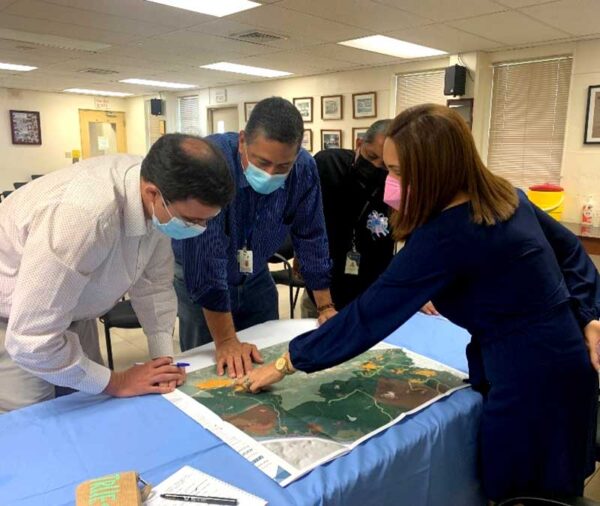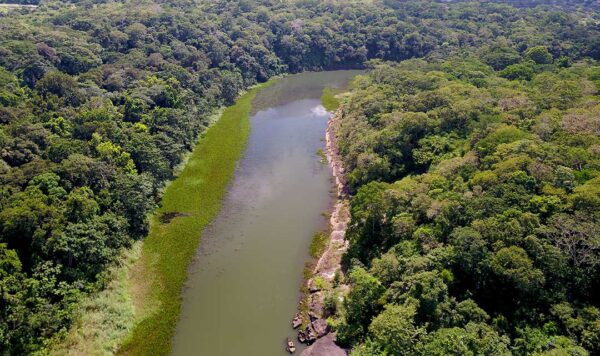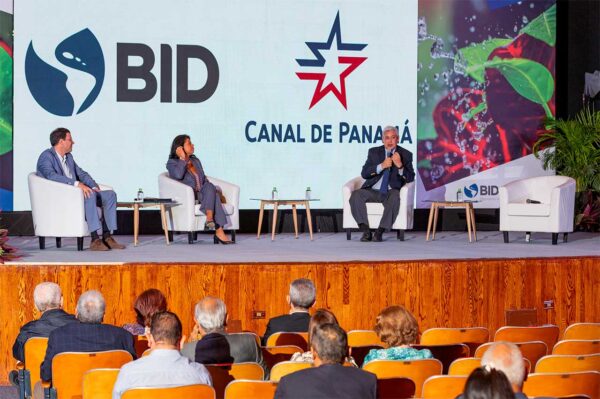Alliances with the IDB will strengthen Canal watershed management
The Panama Canal has new planning instruments to strengthen the management of its watershed, following the presentation and delivery of […]
The Panama Canal has new planning instruments to strengthen the management of its watershed, following the presentation and delivery of the Sustainable Development and Decarbonization Strategy (EDSD) and the Indicative Environmental Land Use Plan (PIOTA) for the Panama Canal Watershed (CHCP).
Both instruments were developed through non-reimbursable technical cooperation from the Inter-American Development Bank (IDB), which began with a comprehensive diagnosis of the Watershed and an analysis of trends and scenarios on the availability of water resources in the future.

“Achieving this was not an easy task,” said Rocio Medina Bolivar, IDB Group representative in Panama, “since these are plans of enormous impact, considering their implications from the economic and environmental point of view, in addition to the contributions they will generate to the country’s decarbonization agenda and that of the Canal,” she said.
All this after approximately two years of work in which the participation of the different actors that affect this region was fundamental.
But what is it about and what are their contributions?
Comprehensive diagnosis
Knowing the existing situation in the Canal Watershed was a priority, in order to formulate the PIOTA. In this diagnosis, problems and opportunities were identified and analyzed from different points of view.
This included knowledge of the existing regulations and the actors that influence the territory, a socioeconomic study of the population, reports on the physical characteristics of the territory, such as geography and the existing water resources, among others.
The complete diagnosis also includes an analysis of the area’s risks, ecosystem services and threats. Marion Le Pommellec, senior specialist in Rural Development at the IDB in Panama, defines it as a kind of holistic vision of the existing problems in the Watershed”.

Prospective: trends and scenarios
This series of technical analyses was developed with different scenarios to assess how the evolution of the future climate may transform reality, and what adaptation measures would be necessary to minimize possible impacts on populations, ecosystems, infrastructure, and activities in the Watershed.
Since water resource management is a fundamental element directly related to the natural and socioeconomic dynamics of the Watershed, the major efforts of these studies focused on this aspect. For Le Pommellec, the objective was to know the future availability of water, for which innovative methodologies were used in search of robust results.

Sustainable Development and Decarbonization Strategy (SDDSD) of the “Green Route 2050” Watershed
This strategy takes the scenarios analyzed in the study “Prospective: trends and scenarios” as a reference. study, in order to develop an instrument that will serve as a guide for future actions.
This will strengthen the positive impacts and reduce the negative impacts of each scenario. The purpose of the ESDD is to reduce the vulnerability of the system to the impacts associated with climate change by promoting resilience and adaptive capacity in development policies and programs, considering that current economic and social development models present characteristics that increase vulnerability and aggravate risk in the face of this great challenge.

The ESDD is developed through four objectives:
- To manage the growth of populated areas in an integrated and sustainable manner, promoting intelligent and orderly population growth;
- Regulate the development of productive activities, promoting low-impact socioeconomic development; 3.
- Guarantee the preservation of natural values, strengthening actions to protect the natural heritage and biodiversity;
- Ensure adaptation and promote climate change mitigation in the CHCP related to decarbonization resilience.
Indicative Plan for Environmental Land Use Planning (PIOTA)
The PIOTA is based on the previous products in order to have an instrument that contributes to the socio-environmental commitment, taking into account existing environmental management, land use planning and factors related to urban and rural development.
This will be done through integrated territorial management with a regional vision, including ecosystems and protected areas that make up about 40% of the Watershed. It also establishes a focus on decarbonization, resilience to climate change and disasters, with the aim of conserving the resource and improving existing socioeconomic conditions.
Le Pommellec believes that the PIOTA, together with the EDSD, establishes the path to achieve sustainable and resilient development in the Watershed. This path will benefit those who live and work there, the future of Canal operations, and the availability of water needed to meet the needs of the metropolitan area.

The riches of a territory
The Panama Canal Watershed (PCWC) is a vast territory: it has a surface area of 3,435 km² in which there are eight protected natural areas. These areas total 1,366 km²; that is, 39.6% of the territory where, according to studies, between 41 and 67% of the country’s biodiversity lives and is a key part of the Mesoamerican Biological Corridor. Daniel Rubio, director of City and Territory of the company IDOM/Mexico, who was in charge of the process, considers that the Watershed is a showcase of biodiversity.
But, in addition to being a natural jewel, the CHCP is the place where 239,000 people live and develop productive activities, dispersed in three provinces, six districts, 38 townships and that have been established in 397 populated places.
These are statistics that, for Panama Canal Administrator Dr. Ricaurte Vásquez, do not go unnoticed. Vasquez maintains that all actions for sustainable development must be planned considering the people who live and depend on the Watershed. There, the Canal already develops programs of this type, which are differentiated due to the socioeconomic characteristics of the different regions.
Working together, the road to success
The formulation of the PIOTA was only possible thanks to a participatory process that, overcoming the limitations brought about by the pandemic, managed to carry out 40 public participation activities, mostly virtual, in which more than 860 institutional actors, from the productive sector, Consultative Councils, Local Committees, Municipalities, NGOs and universities took part.
Proceeding now with its implementation will require new commitments. Both the Canal Administrator and the IDB Group representative in Panama agree on the importance of establishing a roadmap in which tasks and responsibilities are divided between the Panama Canal and the central government, and which also includes the participation and contributions of the rest of the stakeholders.
For the Panama Canal, water resources are a priority, and therefore, together with its strategic allies, it will continue to promote initiatives that promote their proper use and conservation, as well as the sustainable development of the Watershed’s communities, whose residents play a fundamental role in these efforts.